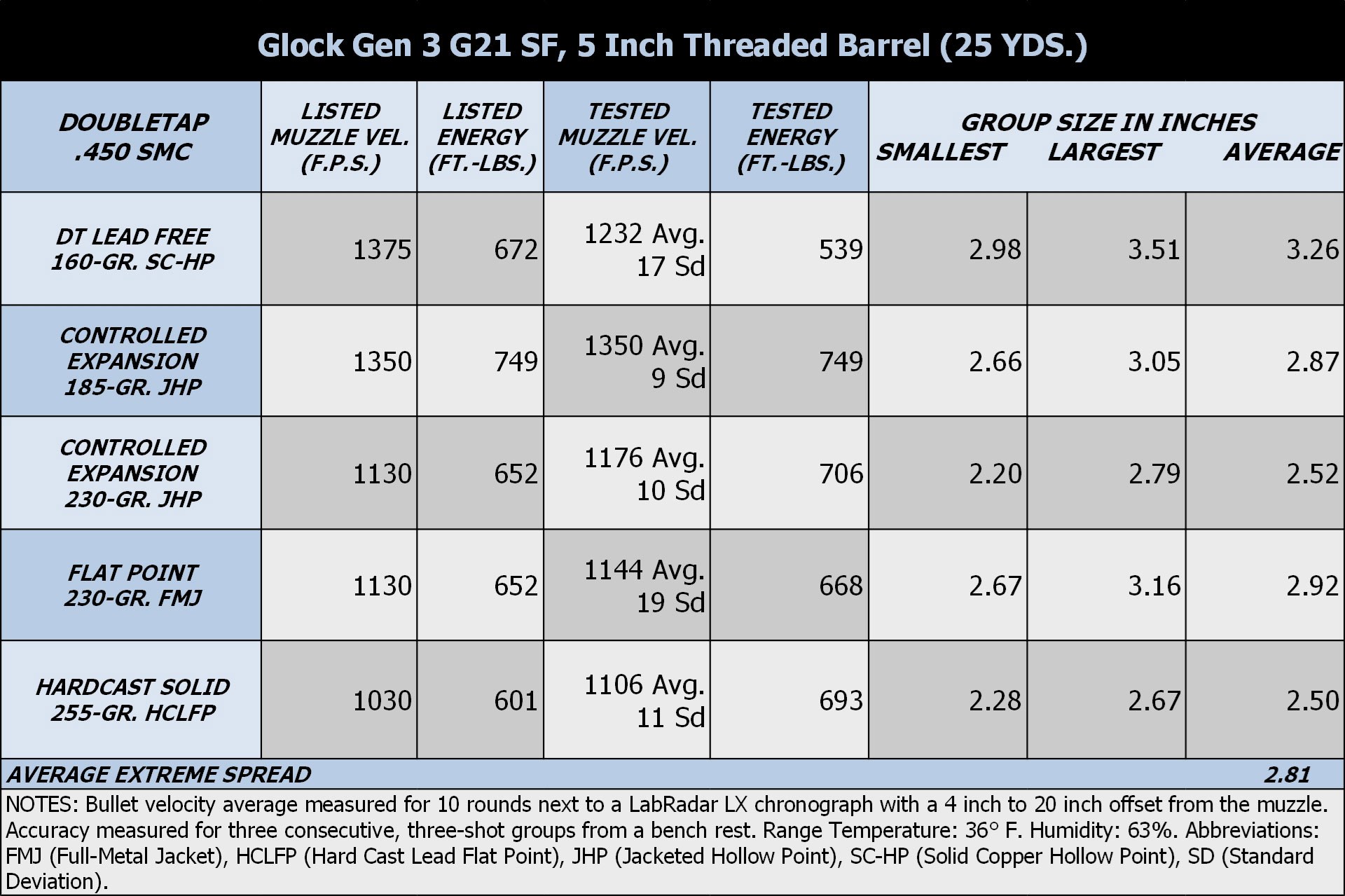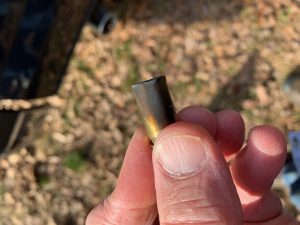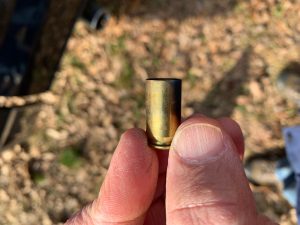Well, maybe it’s not quite the 10mm killer, since they’re about equal in energy delivered to target (based purely on computations, absent a gel test). But in this article I hope to explain what the 450 SMC is and why I choose to carry it for dangerous game.
I’ve written about the 450 SMC before about five years ago and also here (that’s how long I’ve been shooting it). There’s a Wikipedia page on the .45 Super, but not the 450 SMC. The 450 SMC is loaded hotter than the .45 Super and thus has a higher muzzle velocity. I will comment that the first time I shot this load, I put two rounds within a couple of inches at 30 feet in less than one second.
For the .45 Super, Wikipedia tells us that “The layout of most M1911 pistols’ chambers presents yet another challenge in that the case head is not fully supported in the cartridge feed ramp area; pushing the envelope in this critical area with too much pressure risks a catastrophic failure, resulting in a case bursting in the chamber. To rule out such a dangerous possibility, Grennell chose to use brass formed from the stronger and more modern .451 Detonics, shortened to the overall length of the .45 ACP design.”
The 450 SMC isn’t too different in design philosophy, in that it uses a thicker case.
The good folks over at Double Tap are always pushing the envelope on power. They might have out-done themselves with the new 450 SMC. This new round is meant to be fired through any firearm that is chambered for 45 ACP +P. It pushes a 185 gr JHP to 1350 fps, a 230 gr JHP to 1200 and a 255 gr hardcast to 1100.
Did you catch that? It came pretty fast. A 185 grain jacketed hollow point, from a 1911, running at 1,350 feet per second. For those of you keeping score at home, that is fast.
How can they do this in a chamber designed for 45 ACP you ask? They use a special cartridge case. The case is essentially a cut down .308. This gives it thicker walls to hold up to the charge.
At the moment Double Tap are the only folks who offer this cartridge. Neither the 450 SMC nor the .45 Super are SAAMI spec cartridges. In order to push the bullets so fast, the primer is changed over from a typical pistol primer to a rifle primer, leaving more room in the case for powder. So the advertised muzzle velocity of the 450 SMC for a 230 grain bullet is 1130 FPS. But also at the moment, Double Tap doesn’t have what I carry for dangerous game in stock, i.e., jacketed flat nose. In my experience they make several runs of this ammunition every year, so you have to watch for it to come in stock.
American Hunter has a nice featured article on the history of the 450 SMC.
Among the best-known and longest-serving military and civilian defensive pistol calibers in the United States is the .45 ACP. Many enthusiasts still praise this member of John Moses Browning’s Automatic Colt Pistol (ACP) cartridge family, which was developed in 1905. It was eventually paired with Browning’s 1911A1 semi-automatic pistol to form one of the most successful gun and ammunition combinations in this country’s shooting-sports history.
But when it comes to more recent online conversations regarding defensive handguns for use on the trail, the .45 ACP often gets short shrift. Polymer-framed 10mm Auto pistols are taking up more holster space in bear country these days. So much so, that even long-time trail-gun favorites, including double-action revolvers chambered in .357 Magnum and .44 Magnum, are taking a back seat.
But despite the 10mm Auto’s popularity, I was not quite ready to write off the .45 ACP cartridge, and the many popular pistols chambered in it, as trail gun options just yet. Recently I found myself in possession of a pair of Taurus TH series pistols, one chambered in .45 ACP and the other in 10mm Auto. I did my best to line up comparable loads in both calibers and shot them side-by-side to compare the performance numbers. But it came as no surprise that even when using +P-rated .45 ACP ammunition, the 10mm was the superior performer.
As an editorial remark, I wouldn’t ever brush aside the 45 ACP as a dangerous game cartridge, and I especially wouldn’t brush aside the .44 magnum. But more on that later. For jacketed ball .45 ACP, I have found that Browning has some they claim will achieve nearly 1000 FPS. I would never carry hollow point for dangerous game defense.
Simply stated, the 10mm Auto can hit harder than a .45 ACP. This is due in no small part to differences in cartridge case pressure tolerance levels. Remember, the 10mm Auto, as envisioned by Colonel Jeff Cooper, was developed to stretch the 1911 pistol’s effective range out to 50-yards. This was done by launching .40-caliber bullets from cartridges operating at a maximum average pressure (MAP) of 37,500 psi. Standard pressure .45 ACP ammunition operates at a maximum of 21,000 psi with the +P loads topping out at 23,000 psi. No matter how you slice it, the 10mm Auto cartridge has the bullet energy potential edge for semi-automatic pistols. Or does it?
Efforts to develop a more powerful, but still .45 ACP-compatible, pistol cartridge can be traced back to the mid 1980s. Gun writer Dean Grennell took the .451 Detonics Magnum cartridge case (which in turn is based on the .45 Winchester Magnum case) and trimmed the length down to match that of the .45 ACP. Operating at up to 28,000 psi, early loads were capable of launching 185-grain bullets at 1,300 fps. which represented an impressive boost in performance. Working in conjunction with Ace Hindman of Ace Custom 45s, the .45 Super cartridge was born.
Unfortunately, the .45 Super would become encumbered by an unusual business choice made by the late Ace Hindman’s son, Garey Hindman. He trademarked the cartridge name “.45 Super.” This meant that any cartridge case, ammunition or firearm manufacturer who stamped .45 Super on their products would have to pay royalties to Hindman. Even though he kept the offering alive, none of the big players in the industry would promote the cartridge which, in turn, resulted in no reliable source for .45 Super brass.
In 1994 the owner of Triton Cartridge, Fernando Coelho, reached out to Garey Hindman to offer his services on behalf of the .45 Super. However, Coelho ran into issues which inspired him to develop his own potent .45 ACP pistol-compatible cartridge starting in 2001. It was dubbed the .450 SMC (Short Magnum Cartridge) so as to not be bound by the .45 Super trademark. Coelho would also modify his cartridge to use a small rifle primer in place of a large pistol primer. This solved the problem of primer flow (the primer flattening out when fired) and made room for additional metal to reinforce the cartridge base.
Triton Cartridge soon began shipping factory-made .450 SMC rounds loaded to 32,000 psi. Although this is not as high of a pressure potential as the 10 mm Auto (37,500 psi), it launches larger bullets. This levels the playing field, especially when compared to standard .45 ACP, .45 ACP +P and .45 Super bullet energy levels. But the .450 SMC would run into some setbacks of its own.
In 2003, Triton Cartridge went out of business. As a result, it looked like this souped-up .45-caliber pistol round was going to slip into obscurity along with it. However, Mike McNett, founder of DoubleTap Ammunition, would swoop in to save the day. In business since 2002, McNett had launched DoubleTap by offering full-power 10mm Auto loads not available from other manufacturers at that time. Recognizing the .450 SMC’s potential, he purchased the rights and tooling to the cartridge and spent a few years tweaking it to get it just right before adding it to the company’s now expansive catalog of pistol and rifle calibers.
Today DoubleTap offers six different loads topped with bullet weighing between 160-grains to 255-grains, with bullet styles including jacketed hollow points, full-metal jacket and hard-cast lead flat nose. Although DoubleTap has offered .450 SMC for some time, it has yet to be officially recognized by the Sporting Arms and Ammunition Manufacturers’ Institute (SAAMI), and thus remains a wildcat cartridge. This ‘unofficial’ cartridge status, along with the lack of pistols built specifically for this round, keeps the .450 SMC flying relatively low on the trail-gun caliber scene.
I’ve mentioned before that I carry my 450 SMC in a modified 1911. The modification is simple. I replaced the 18# recoil spring with a 22# recoil spring from Wolff Gunsprings. American Hunter does bring up the need to pay attention to the spring.
DoubleTap maintains in their literature that the .450 SMC cartridge can be safely fired in any .45 ACP pistol, revolver or carbine which is rated for .45 ACP +P ammunition, no modifications required. Although this statement is technically correct, it’s also incomplete. If you spend any time researching the .45 Super or similar cartridges, the one thing that gets mentioned time and again is the benefit of using a heavier recoil spring weight.
There is much more about the testing at American Hunter. But the money is here in the table of results.

And then finally, in this table.

It’s just not true that 10mm is a better option than 45, if you assume that the ammunition of choice is 450 SMC.
There are handguns that will shoot 450 SMC which are larger frame polymer pistols if that’s your choice, but I choose to use a 1911. This is for several reasons. My arthritis has swollen the knuckles on my right hand almost beyond recognition (I can still pull a trigger with ease), but I like the 1911 for its narrow frame. Also, I don’t shoot striker-fired handguns. I only have hammer fired handguns, and I very much like the tactile trigger.
As for magazine capacity, it’s true that the most you will find with the usual 1911 magazines is eight rounds (or maybe seven). But if you desire, both Wilson Combat and Chip McCormick sell 10-round magazines (although they’re slightly longer). The single stack design doesn’t bother me – again, I like it and choose to shoot the 1911 exactly for this reason.
Shooting Illustrated claims that the 450 SMC generates 78% more recoil than the .45 ACP. As I’ve said, I cannot confirm that from shooting the cartridge, although I’ve never measured it. My experience with the cartridge just doesn’t bear that out. I find it about as easy to shoot as .45 ACP.
If you want more, there’s always the .44 magnum in a wheel gun, or for semi-auto design, you can do a conversion to 460 Rowland. I have hiked out West and carried a .44 magnum and a 1911 with 450 SMC. I’ve never felt under-gunned with either firearm, although if I spent more time out West, I would probably lean towards the .44 magnum.
In the East, for dangerous game defense, we would primarily face black bear, Coyotes and feral hogs (if they’re “runners” they turn and try to get away – though I’ve seen the opposite before, and with the tusks the males sport, your femoral artery is in danger). For the West, brown and grizzly bears are a different story. For the record, while in Colorado, according to conversations with folks who had been where I was headed, Moose were the most dangerous threat (they will stomp you). Without any hesitation, I carried the 450 SMC and never felt vulnerable.
In the end what you carry is up to you. But don’t believe the hype that the only choice in a semiautomatic handgun is the 10mm. That cartridge is a viable choice, but it’s not the only one. There is 450 SMC, and then there is 460 Rowland for a slight step up. I’ve carried 450 SMC hiking in dangerous game territory, and may carry it while hunting, but for hunting it depends on how accessible I intend to keep my rifle. If my hunting is near a deer stand, I may carry a smaller caliber.







